15 Types of the Most Common Butterflies in Colorado (With Pictures)
-
Kristin Hitchcock
- Last updated:

In all, Colorado has about 80 species of butterflies. Of course, some of these are extremely common, while others are difficult to find (either because their populations are low or because they don’t spend much time in the state).
In many cases, the average person will never see all of these butterflies, even if you live in Colorado. However, there are a few species that everyone will see at least once, as they are pretty common.
Below, we’ve listed some of these more common species to help you recognize them when you come across them. Most are pretty easy to identify.
The 15 Types of the Most Common Butterflies in Colorado
1. Black Swallowtail
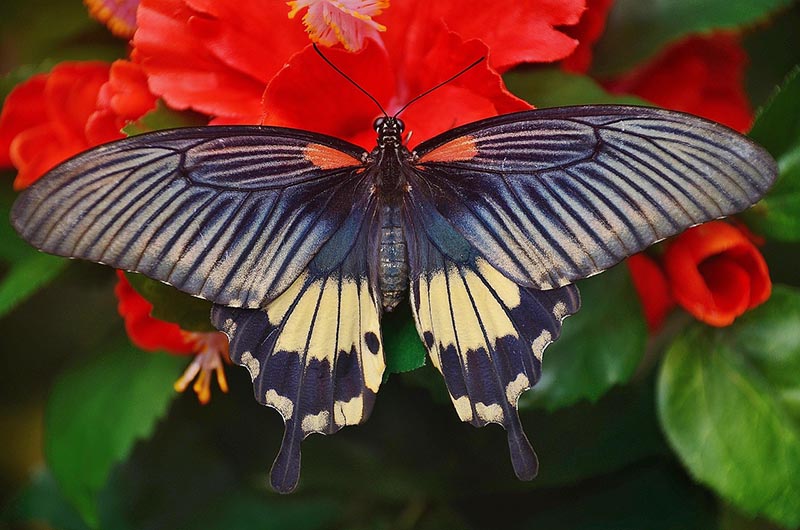
| Family: | Papilionidae |
| Food: | Plants from the family Lauraceae, Rutaceae, and Umbelliferae |
The Black Swallowtail is one of the most common butterflies in Colorado, and this species is easily recognizable. They are primarily black, but the far side of their wings has small yellow spots or a band. Females also have iridescent blue markings near the end of the wings.
On the inner wings, each gender also has an orange “bull’s eye” marking.
You will find these butterflies most commonly in the eastern part of the state. However, they are technically found everywhere.
2. Monarch
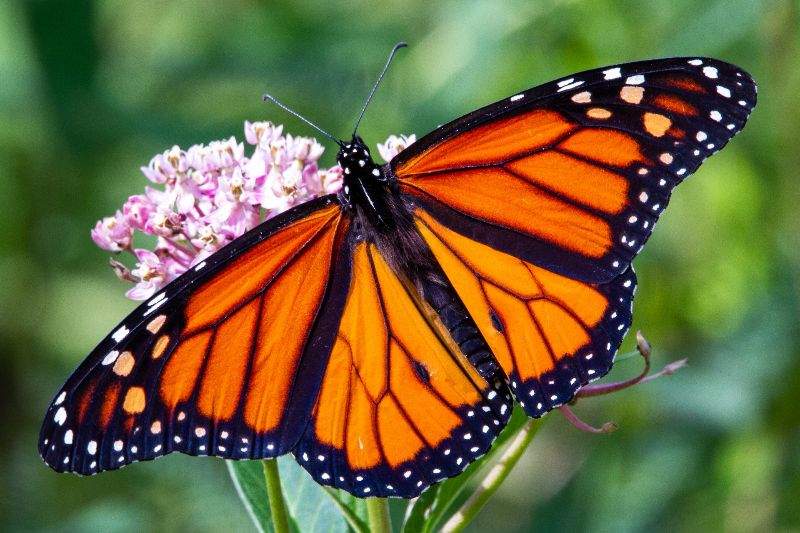
| Family: | Nymphalidae |
| Food: | Milkweed (and other plants as adults) |
This species is easily one of the most famous butterflies. They are best known for their long migration, though not all Monarchs migrate. Instead, only a particular subspecies migrates. While the average monarch is not threatened, the migratory subspecies are endangered. Either way, this is one of the most studied butterfly species.
Their wings are recognizable thanks to the bright orange coloration surrounded by a black border. The females are much more vibrant than the males, which can have slightly murky coloring.
The migratory subspecies migrates between March and June each year. There are many types of Monarchs in Colorado, though telling the difference between them can be challenging.
3. Painted Lady
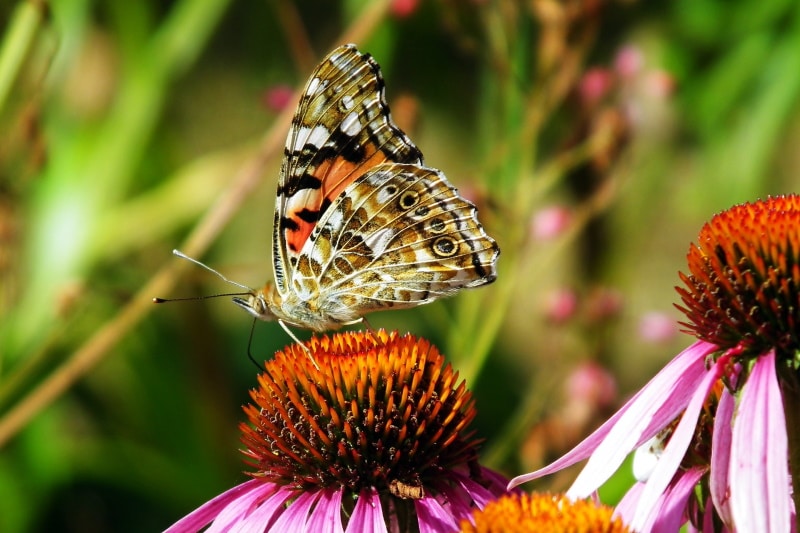
| Family: | Nymphalidae |
| Food: | Flower nectar and aphids (of all types) |
The Painted Lady Butterfly isn’t well-known, but it is extremely common in Colorado. It looks like a monarch, so the two species are often mixed up. However, the details of the wings are very different and easy to pick up once you know the difference.
These butterflies prefer open areas and fields, where they can be seen feeding on flowers. This butterfly is one of the most common in the world, being found in North America, Central America, Africa, Europe, and Asia.
This butterfly is one of the few that doesn’t discriminate their food source or host plant. Therefore, you can find them eating and laying eggs on almost everything.
4. Two-Tailed Swallowtail
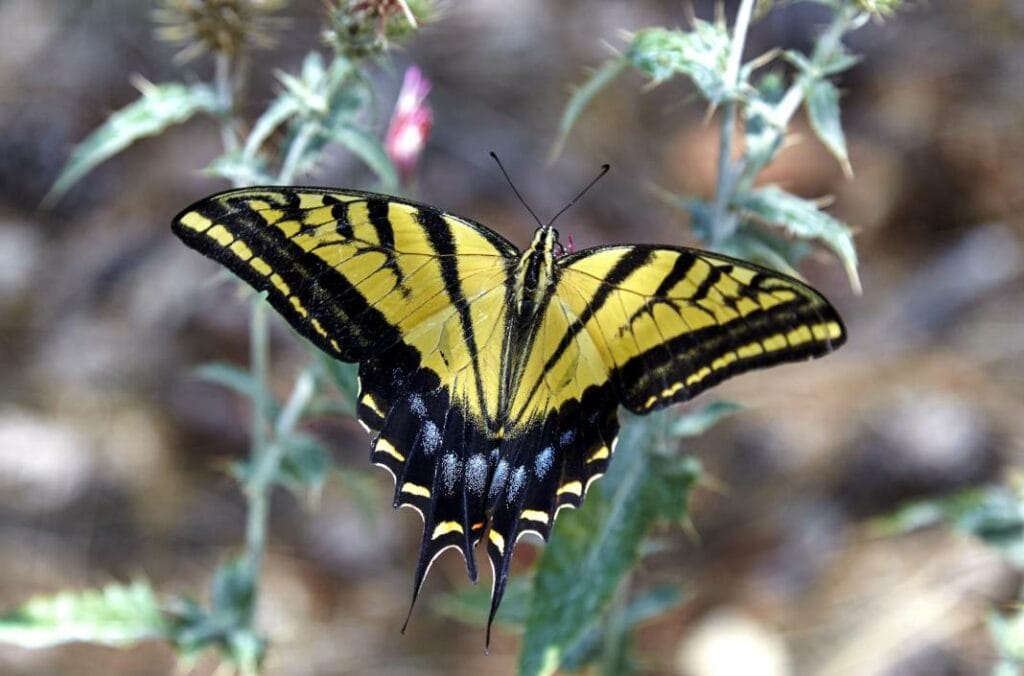
| Family: | Papilionidae |
| Food: |
Chokecherry, bitter cherry, Arizona rosewood, single-leaf ash, hoptree, and Arizona sycamore
|
The Two-Tailed Swallowtail is another giant butterfly you can easily find in Colorado. These butterflies can have a wingspan of up to five inches, making them one of the larger ones on this list. They are seen throughout the state, but they primarily hang around ash trees. Therefore, to bring them into your yard, consider planting an ash tree or two.
The Two-Tailed Swallowtail is the state butterfly of Arizona. However, you can find it across much of the United States.
5. Checkered Skipper

| Family: | Hesperiidae |
| Food: | Flower nectar |
The Checkered Skipper doesn’t look like what most people would imagine a butterfly to look like. However, they are decently common butterflies in Colorado and look strange for a reason. This butterfly is best known for being the fastest butterfly in the world. They can reach speeds up to 37 miles per hour (the average butterfly is around 5 to 12 mph).
This species adapts to changes in elevation very well, so you’ll find it throughout Colorado. It thrives in the state due to the rapid elevation changes, which not all butterflies can handle.
It gets its name from the blue-gray checkering found on males. Females are brown or black with a similar, white checkered pattern.
6. Red Admiral Butterfly
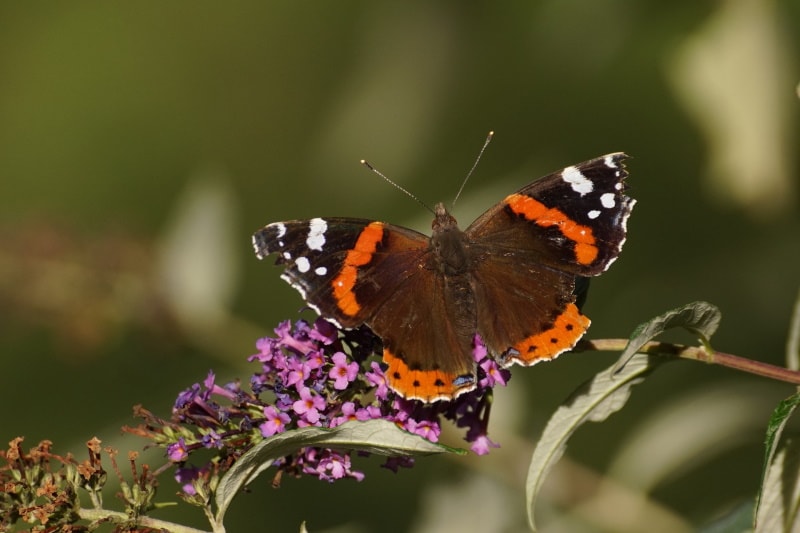
| Family: | Nymphalidae |
| Food: | Stinging nettle |
This easily recognizable butterfly has black wings with very vibrant orange stripes. The outer part of the wing also has an orange stripe. They are medium-sized with a wingspan of about 2 inches. They are found throughout Colorado and in many other places, too.
This butterfly’s primary host plant is the stinging nettle. However, adult butterflies aren’t as picky. They will consume flower nectar from about any plant and overripe fruit. Unlike most butterflies, they are also territorial.
Furthermore, these butterflies have a unique mating pattern that involves the males courting the females. Females will only mate with territory-controlling males. Those with better flight abilities are more likely to score a mate.
7. Western-Tailed Blue Butterfly
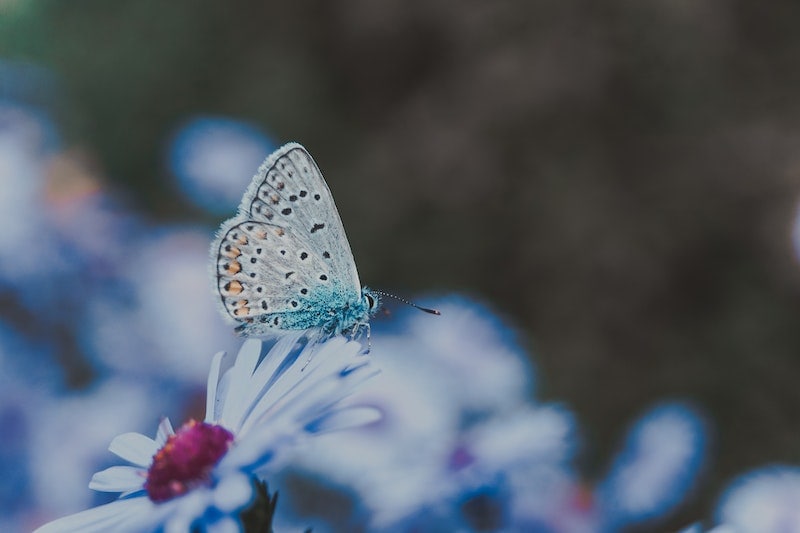
| Family: | Lycaenidae |
| Food: |
Astragalus (several species), Lathyrus (several species), Oxytropis, and Vicia (several species)
|
Despite the name, only the males in this species are blue. The females are a slate gray with slight blue towards the wing base. This species can be commonly spotted in Colorado between March and July. While it might not look like it, they have a tail underneath their hindwing. Therefore, they are technically “tailed.”
These butterflies are smaller, with their wingspan hardly exceeding an inch. They feed on many different species of plants, with the adults not being very picky about what they eat. Adults may even feed on mud and similar materials.
8. Common Buckeye

| Family: | Nymphalidae |
| Food: | Plants with iridoid glycosides |
As you’d expect, the Common Buckeye is pretty standard. They also have eye-like markings on their wings, which is where they get their name from. Therefore, it is pretty easy to recognize these butterflies if you can get close enough.
These butterflies prefer open ground with a small amount of vegetation or no vegetation at all.
The larvae prefer to feed on plants containing iridoid glycosides, which help them grow faster. However, most other insects can not handle this chemical, making caterpillars that eat them slightly toxic. (While the chemical doesn’t kill outright, it can cause chemical starvation and stunted growth in other insects.) Therefore, the survival of the larvae largely depends on them consuming these plants.
9. Cabbage White
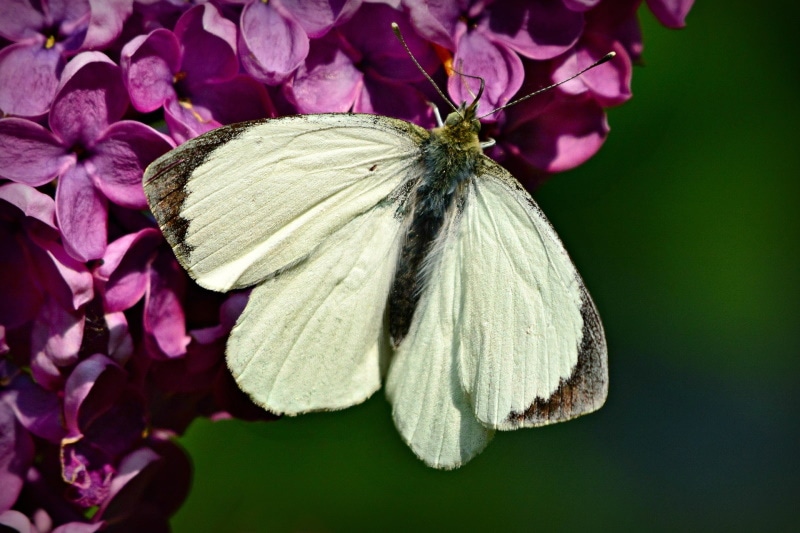
| Family: | Pieridae |
| Food: | Crucifer crops |
As the name suggests, this species is exceptionally white. They are easy to identify for this reason, and you can find them throughout the state. This species is very similar to another in Europe, but the two have been separated into distinctive species.
Their larvae are commonly called “imported cabbageworm.” It is a common pest to cabbage, kale, bok choy, and similar crops. This species was likely transported into the Americas during colonization. While the butterfly has been around for a while, they are still considered invasive.
10. Mourning Cloak
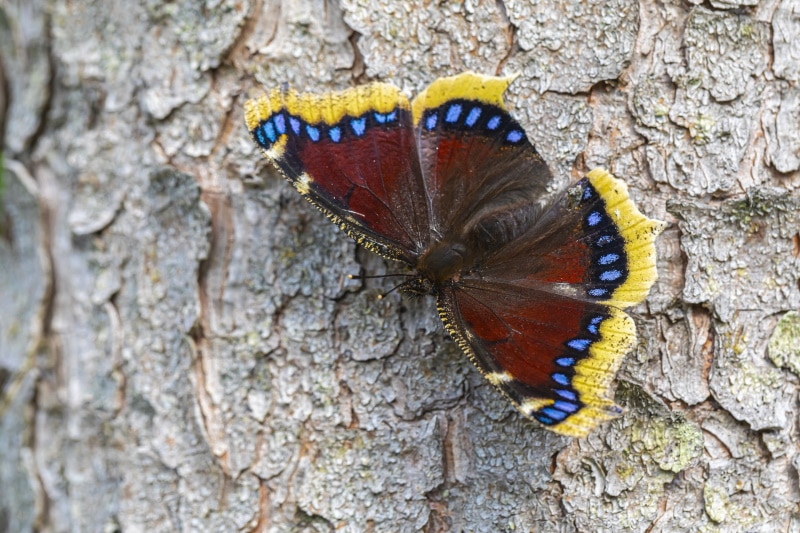
| Family: | Nymphalidae |
| Food: | Willow, American elm, hackberry, hawthorn, wild rose, Betula species, Alnus incana, poplar |
This butterfly features a pretty unique coloration. The inner part of their wings is black in color, while the outside is light yellow or brown. Blue-purple spots appear along the outer edge of their wings, as well.
This species can be found worldwide, but it is often called different things depending on where you are. For instance, in Britain, it is called the Camberwell beauty. The larvae are sometimes called spiny elm caterpillars. Names like Grand Surprise and White Petticoat are sometimes used, too.
This species is a powerful flyer and migratory in some areas. Therefore, they can often be found outside their “usual” range. They also have the most extended lifespan of any butterfly at up to a year.
11. Hoary Comma
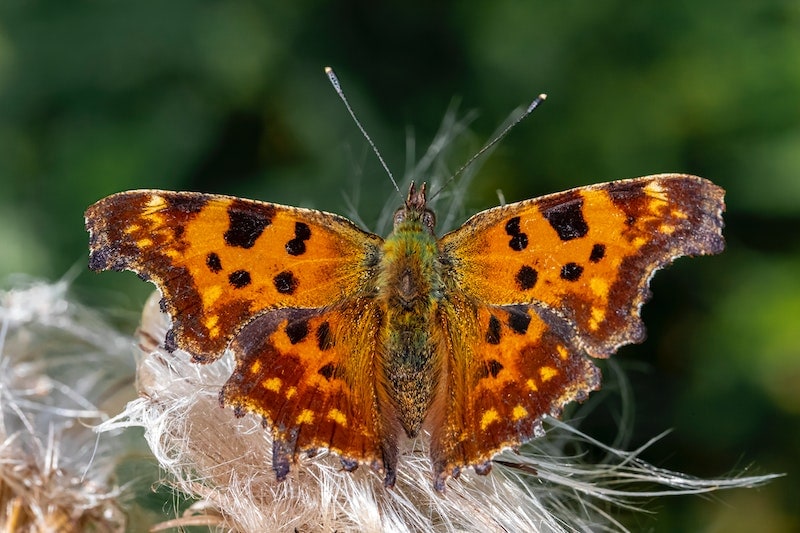
| Family: | Nymphalidae |
| Food: | Tree sap, shrubbery, nectar |
This species of butterfly can be found throughout North America, from Alaska to New Mexico. They are pretty standard in Colorado, though not necessarily as common as other butterflies. Their wings are fringed and not straight, which makes them easy to identify. These butterflies typically look injured—like something has bitten chunks out of their wings.
The adult butterflies feed on tree sap and various kinds of nectar. However, the caterpillars mostly feed on shrubbery.
12. Variegated Fritillary
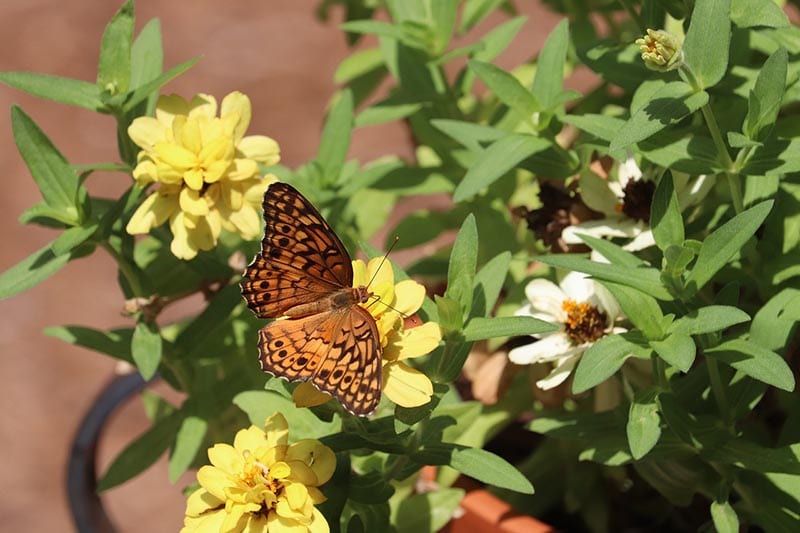
| Family: | Nymphalidae |
| Food: | Just about anything |
These butterflies are very similar to other fritillaries—so much so that it is sometimes hard to tell the difference. However, there are a few traits that set this species apart. For instance, they can lay multiple sets of eggs a year, are nomadic, and use many different host plants. When they fly, these butterflies tend to fly low and stiffly.
However, this species is known for being very untrusting. They quickly flutter away when you try to approach them. In fact, their genus name is taken from the Greek word meaning “easily scared.”
13. Clouded Sulphur
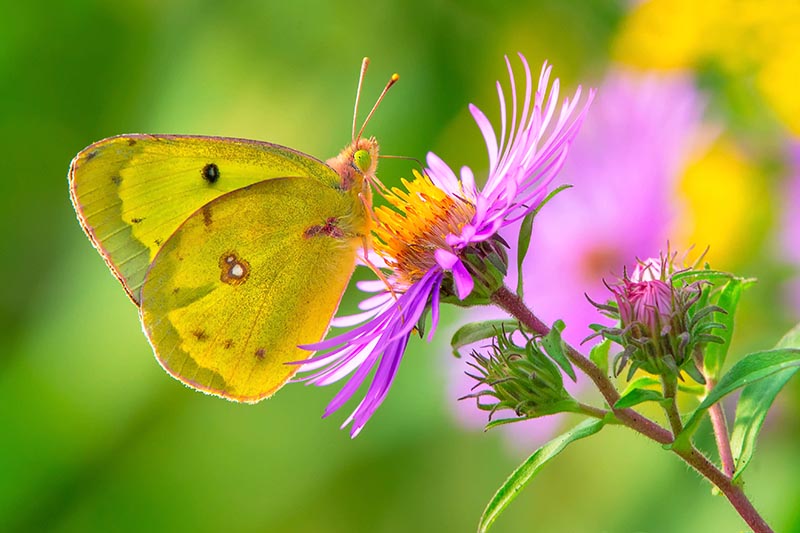
| Family: | Pieridae |
| Food: |
Milkweeds, butterfly bush, coneflower, alfalfa, dandelion, clover, ground plum, milk-vetch, and many others
|
Simply put, this butterfly is yellow. Their wings are yellow. Their eyes are yellow. Their body is yellow. If you see a solid yellow butterfly, it is probably a Clouded Sulphur. Males have very defined borders, while females may be more spotted. Sometimes, females may also be whiter.
These butterflies are most commonly found in fields, lawns, clover patches, meadows, and roadsides. They congregate around a food source, so it isn’t odd to see quite a few at once. This species is also migratory, so they aren’t in Colorado for the whole year.
14. Rocky Mountain Parnassian
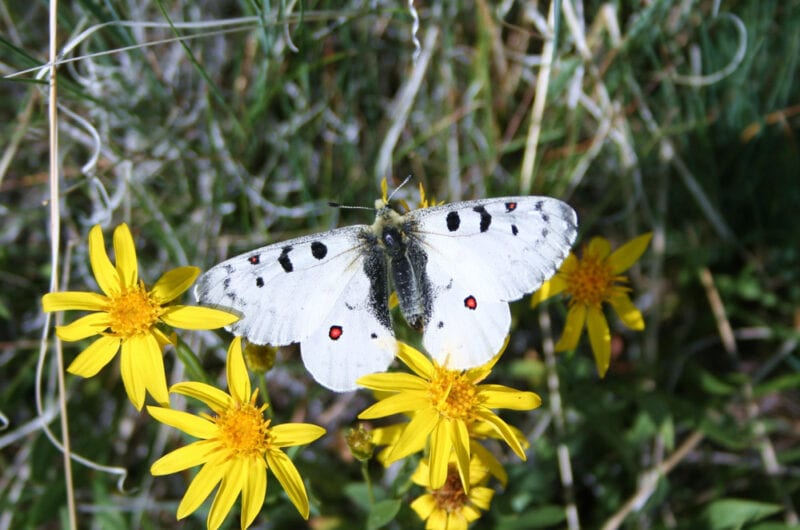
| Family: | Papilionidae |
| Food: | Spearleaf stonecrop |
As the name suggests, this butterfly hangs out around the Rocky Mountains and prefers high altitudes. They range in color from white to pale yellow. Most individuals have black and red markings, which express their unpalatable taste to predators.
As an adult and larva, this butterfly mostly eats the Sedum lanceolatum plant. Therefore, they tend to reside anywhere this plant is common, such as in meadows and alongside roads. They strongly prefer the light, so they usually don’t wander into the forest. However, males do fly meadow to meadow in search of females so that they may appear in forests during their trips.
15. Colorado Hairstreak
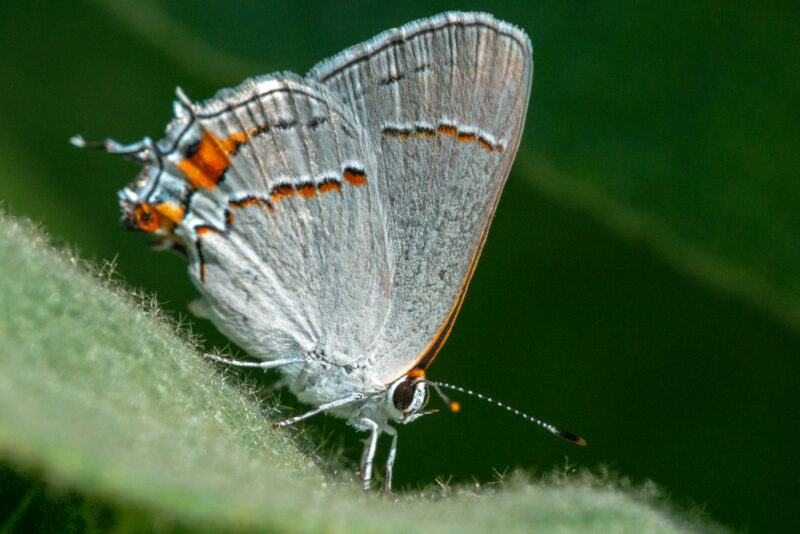
| Family: | Lycaenidae |
| Food: | Gambel oak |
You can’t finish a list of Colorado butterflies without listing the state’s official insect: the Colorado Hairstreak. This butterfly isn’t only found in Colorado. However, it was named the state’s official insect in 1996.
Their wings are dark purple with a dark border. Each wing features orange spots around the edges, and they have a very thin tail.
This species relies upon the Gambel oak, so its range is primarily tied to this tree. Both the caterpillars and adults rely on this tree for food, though they can make do with other oak species, too. The adults do not feed on insects but instead subsist primarily on tree sap from oak trees.
Conclusion
There are many different butterfly species found throughout Colorado. However, most of them are not very common and won’t be spotted by the average person usually. Most butterflies that are easily identifiable and commonly seen fall into a few different species. Recognizing these species is usually pretty easy, especially since they all have unique patterns and colors.
All of these species also rely on different plants for survival. While some aren’t picky about their food, others rely on one particular species to thrive. If you want to attract them to your yard, it’s vital that you plant flowers and plants they need to thrive.
- Colorado Hairstreak
- Parnassius Smintheus
- Colias Philodice
- Euptoieta Claudia
- Hoary Comma
- Nymphalis Antiopa
- Pieris Rapae
- Junonia Coenia
- Western Tailed-Blue
- Vanessa Atalanta
- Carterocephalus
- Papilio Multicaudata
- Vanessa Cardui
- Monarch Butterfly
- Papilio Polyxenes
- Out There Colorado
- Uncover Colorado
- Colorado Front Range Butterflies
Featured Image Credit: Joshua J. Cotten, Unsplash
Contents
